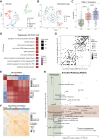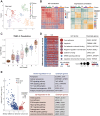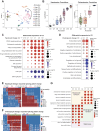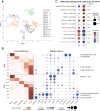Interrogations of single-cell RNA splicing landscapes with SCASL define new cell identities with physiological relevance
- PMID: 38461306
- PMCID: PMC10925056
- DOI: 10.1038/s41467-024-46480-9
Interrogations of single-cell RNA splicing landscapes with SCASL define new cell identities with physiological relevance
Abstract
RNA splicing shapes the gene regulatory programs that underlie various physiological and disease processes. Here, we present the SCASL (single-cell clustering based on alternative splicing landscapes) method for interrogating the heterogeneity of RNA splicing with single-cell RNA-seq data. SCASL resolves the issue of biased and sparse data coverage on single-cell RNA splicing and provides a new scheme for classifications of cell identities. With previously published datasets as examples, SCASL identifies new cell clusters indicating potentially precancerous and early-tumor stages in triple-negative breast cancer, illustrates cell lineages of embryonic liver development, and provides fine clusters of highly heterogeneous tumor-associated CD4 and CD8 T cells with functional and physiological relevance. Most of these findings are not readily available via conventional cell clustering based on single-cell gene expression data. Our study shows the potential of SCASL in revealing the intrinsic RNA splicing heterogeneity and generating biological insights into the dynamic and functional cell landscapes in complex tissues.
© 2024. The Author(s).
Conflict of interest statement
The authors declare no competing interests.
Figures






Similar articles
-
Clustering of mRNA-Seq data based on alternative splicing patterns.Biostatistics. 2017 Apr 1;18(2):295-307. doi: 10.1093/biostatistics/kxw044. Biostatistics. 2017. PMID: 27780810 Free PMC article.
-
BRIE: transcriptome-wide splicing quantification in single cells.Genome Biol. 2017 Jun 27;18(1):123. doi: 10.1186/s13059-017-1248-5. Genome Biol. 2017. PMID: 28655331 Free PMC article.
-
Exploiting single-cell RNA sequencing data to link alternative splicing and cancer heterogeneity: A computational approach.Int J Biochem Cell Biol. 2019 Mar;108:51-60. doi: 10.1016/j.biocel.2018.12.015. Epub 2019 Jan 8. Int J Biochem Cell Biol. 2019. PMID: 30633986
-
Pre-RNA splicing in metabolic homeostasis and liver disease.Trends Endocrinol Metab. 2023 Dec;34(12):823-837. doi: 10.1016/j.tem.2023.08.007. Epub 2023 Sep 4. Trends Endocrinol Metab. 2023. PMID: 37673766 Review.
-
Roles and mechanisms of alternative splicing in cancer - implications for care.Nat Rev Clin Oncol. 2020 Aug;17(8):457-474. doi: 10.1038/s41571-020-0350-x. Epub 2020 Apr 17. Nat Rev Clin Oncol. 2020. PMID: 32303702 Review.
Cited by
-
Computational methods for alternative polyadenylation and splicing in post-transcriptional gene regulation.Exp Mol Med. 2025 Aug;57(8):1631-1640. doi: 10.1038/s12276-025-01496-z. Epub 2025 Aug 14. Exp Mol Med. 2025. PMID: 40804481 Review.
-
sc-SPLASH provides ultra-efficient reference-free discovery in barcoded single-cell sequencing.bioRxiv [Preprint]. 2024 Dec 24:2024.12.24.630263. doi: 10.1101/2024.12.24.630263. bioRxiv. 2024. PMID: 39763839 Free PMC article. Preprint.
-
Beyond the Heartbeat: Single-Cell Omics Redefining Cardiovascular Research.Curr Cardiol Rep. 2024 Nov;26(11):1183-1196. doi: 10.1007/s11886-024-02117-3. Epub 2024 Aug 19. Curr Cardiol Rep. 2024. PMID: 39158785 Review.
-
DOLPHIN advances single-cell transcriptomics beyond gene level by leveraging exon and junction reads.Nat Commun. 2025 Jul 4;16(1):6202. doi: 10.1038/s41467-025-61580-w. Nat Commun. 2025. PMID: 40615408 Free PMC article.
-
Mechanisms of RNA alternative splicing dysregulation in triple-negative breast cancer.Zhong Nan Da Xue Xue Bao Yi Xue Ban. 2024 Jul 28;49(7):1143-1154. doi: 10.11817/j.issn.1672-7347.2024.240434. Zhong Nan Da Xue Xue Bao Yi Xue Ban. 2024. PMID: 39788502 Free PMC article. Review. Chinese, English.
References
MeSH terms
Grants and funding
LinkOut - more resources
Full Text Sources
Medical
Research Materials

